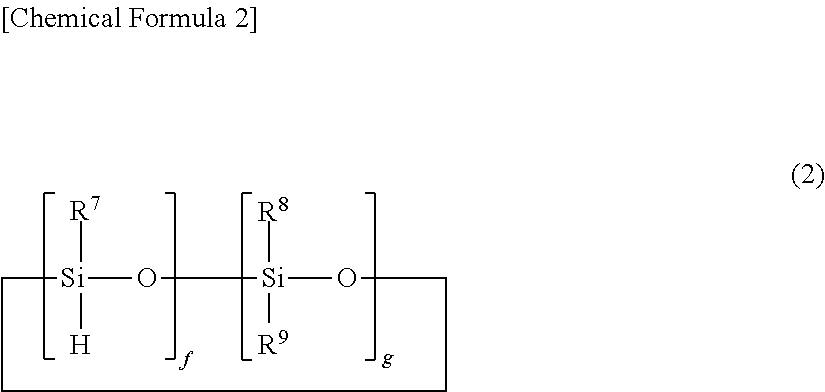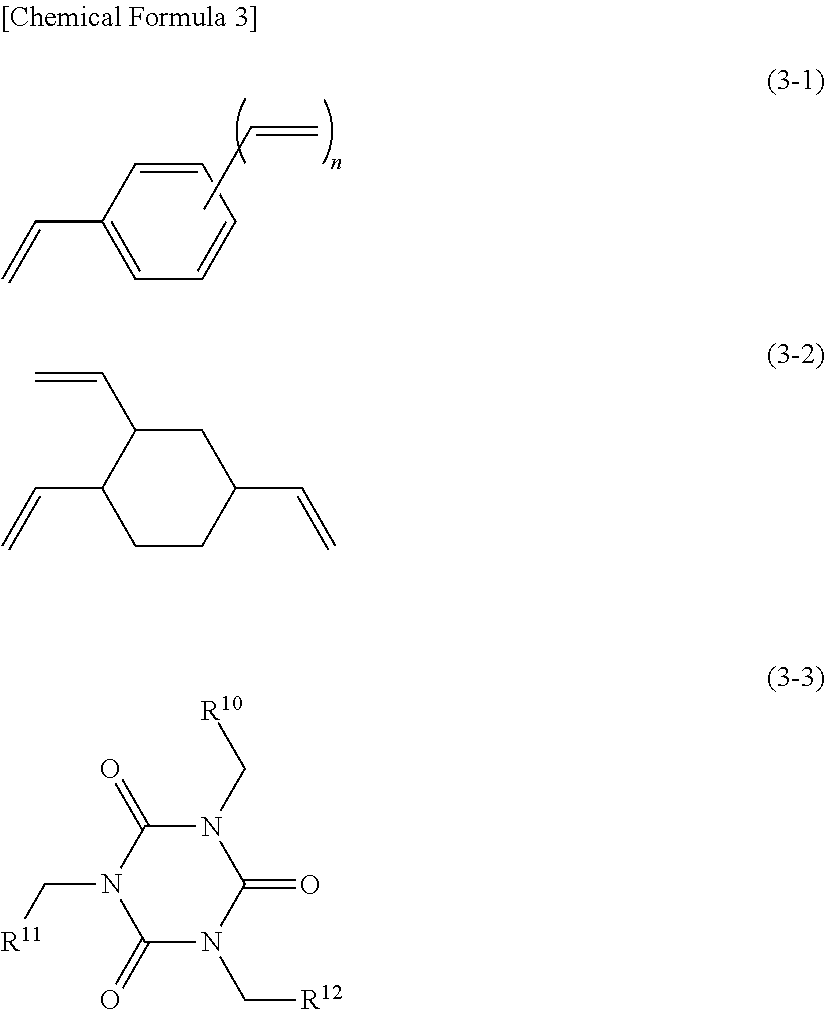Silicon-containing curing composition and cured product thereof
a technology of curing composition and curing product, which is applied in the direction of semiconductor devices, solid-state devices, semiconductor/solid-state device details, etc., can solve the problems of limited use, unsatisfactory performance requirements in the recent electronic information field, heat resistance, crack resistance, crack resistance, etc., to reduce weight loss temperature, good curability, and excellent heat resistance and crack resistance
- Summary
- Abstract
- Description
- Claims
- Application Information
AI Technical Summary
Benefits of technology
Problems solved by technology
Method used
Image
Examples
synthesis example 1
Synthesis of Silicon-Containing Polymer A-1 as Component (A)
[0129]In a 2000 ml four-necked flask equipped with a condenser tube and a stirrer were put 0.5 mol of vinyltrimethoxysilane as component (a), 0.5 mol of methyltrimethoxysilane as component (b), 0.25 mol of dimethyldimethoxysilane as component (c), 1.0 mol of phenyltrimethoxysilane as component (d), and 650 g of toluene. To the mixture was added dropwise 31.4 g of a 0.5% sodium hydroxide aqueous solution over a period of 30 minutes while stirring, to cause dehydration polymerization at 60° to 65° C. for 3 hours. The reaction mixture was cooled to room temperature, and 600 g of toluene and 1500 g of ion exchanged water were added to extract the oily phase, which was washed with water until the washing became neutral. The solvent was removed to give 232.6 g of silicon-containing polymer A-1 as white powder (component A). Silicon-containing polymer A-1 was analyzed by GPC under the following conditions and found to have a polys...
synthesis example 2
Synthesis of Silicon-Containing Polymer A-2 as Component (A)
[0130]In a 1000 ml four-necked flask equipped with a condenser tube and a stirrer were put 0.139 mol of vinyltrimethoxysilane as component (a), 0.278 mol of methyltriethoxysilane as component (b), 0.056 mol of dimethyldimethoxysilane and 0.034 mol of diphenylsilanediol as component (c), 0.05 mol of phenyltrimethoxysilane as component (d), and 280 g of methyl ethyl ketone. To the mixture was added dropwise 30 g of a 0.1% oxalic acid aqueous solution while stirring, followed by stirring at room temperature for 1 hour. To the reaction system was added dropwise 40 g of a 0.1% sodium hydroxide aqueous solution while stirring to cause dehydration polymerization under reflux for 10 hours. The reaction mixture was cooled to room temperature, and 50 g of ion exchanged water was added to extract the oily phase, which was washed with water until the washing became neutral. The solvent was removed to give 52 g of silicon-containing pol...
synthesis example 3
Synthesis of Prepolymer B-1 as Component (B)
[0131]A hundred parts of 1,3,5,7-tetramethylcyclotetrasiloxane, 100 parts of divinylbenzene, 60 parts of toluene, and 0.0005 parts of a platinum-carbonylvinylmethyl complex (Ossko catalyst) were mixed and refluxed for 5 hours while stirring. The solvent was removed by evaporation under reduced pressure at 70° C. to yield prepolymer B-1 as component (B).
[0132]Prepolymer B-1 was found to have an Mw of 140,000 as a result of GPC under the conditions described supra and a hydrosilyl group (Si—H) content of 5.3 mmol / g as a result of 1H-NMR.
PUM
| Property | Measurement | Unit |
|---|---|---|
| particle size | aaaaa | aaaaa |
| bending strength | aaaaa | aaaaa |
| pH | aaaaa | aaaaa |
Abstract
Description
Claims
Application Information
 Login to View More
Login to View More - R&D
- Intellectual Property
- Life Sciences
- Materials
- Tech Scout
- Unparalleled Data Quality
- Higher Quality Content
- 60% Fewer Hallucinations
Browse by: Latest US Patents, China's latest patents, Technical Efficacy Thesaurus, Application Domain, Technology Topic, Popular Technical Reports.
© 2025 PatSnap. All rights reserved.Legal|Privacy policy|Modern Slavery Act Transparency Statement|Sitemap|About US| Contact US: help@patsnap.com



